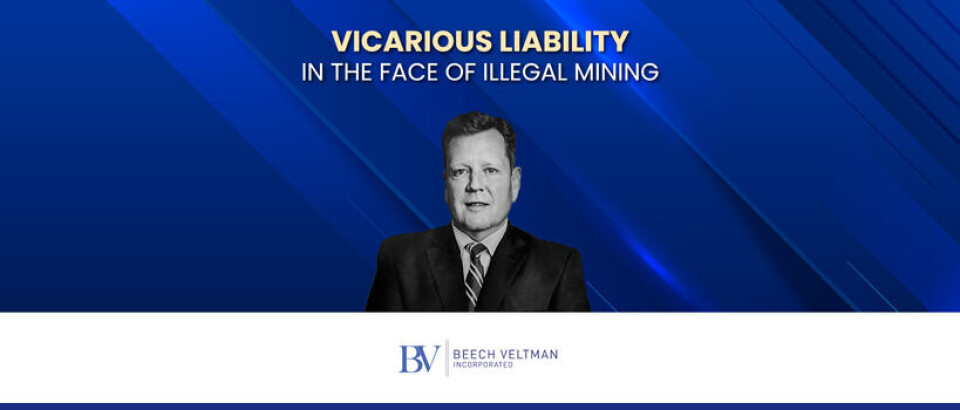Illegal mining is extremely dangerous for several reasons, including that the illegal miners do not work within the statutory framework requirements and do not apply health, safety and environmental laws. Successful illegal mining requires cooperation from a complex web of participants, sometimes including employees of mining companies (and employees of service providers to the mines) that are carrying out their mining operations lawfully.
Often illegal mining is carried out alongside lawful mining operations, and illegal intrusions onto mines that are being operated lawfully are now commonplace. This brings up at least two considerations: (a) access to and accessibility of the mine, and (b) the consequences if an illegal miner (or another person) dies or is injured on mine property.
Let me sketch a scenario: A group of illegal miners approaches a security guard employed by a mine, payment is made and the security guard unlocks the gate, allowing the illegal miners to enter and leave the mine as they require. A member of a nearby community walks past the unlocked or open gate and decides to take a short cut across the mine. While walking across the mine this member of the community falls into an accumulation of water and drowns.
A number of laws will apply to this scenario, but in this article we address the key question of whether or not the mining company can be held vicariously liable for the death of the community member. We’ll look at this within the context of the judgment of the High Court of South Africa in the matter between Oudehoutkloof Boerdery (Pty) Ltd and Others v Jan Louis Venter which was handed down on 16 September 2021 (Oudehoutkloof Judgment).
The point of departure is that an employer is responsible for the delicts (intentional or negligent acts or omissions) of an employee committed in the course of employment. However, an employer has not, historically, been held responsible for the acts performed by an employee solely for their own interests and purposes, and outside their authority.
As the court in the Oudehoutkloof Judgment stated, vicarious liability is normally not challenging to apply where the employee commits a delict while solely or partially going about the business of the employer. However, when an employee commits an intentional wrong entirely for his/her own purposes, it is not as easy.
The modern test for vicarious liability is based on the majority judgement of the court in Minister of Police v Rabie 1986 (1) SA 117(A), where the test for vicarious liability in cases of “deviation” from authorised duty, is summarised as follows:
- If an employee is attempting, even if it is done improperly, to advance his/her employer’s interests, the employer may be vicariously liable. This is a subjective test. On the subjective test there would be no vicarious liability if the employee was acting solely in his/her own interests;
- Even if there is no vicarious liability on the subjective test, the employer may still be liable if, objectively, there is a sufficiently close link between the employee’s acts for his/her own interests and the purposes and business of the employer. This is an objective test.
It is of course a complex question to determine what constitutes “sufficiently close”. The general principle is that where the business of the employer furnished the “mere opportunity to the employee to commit the wrong”, this would typically not be sufficient to create a causal link.
Where, objectively, there is closeness of purpose, planning and effect in the fraudulent actions of employees, which resembled what they are employed to do, it is possible to hold the employer vicariously liable. The policy reasons underlying this, are that an employer must bear the burden of employee wrongdoing in the absence of any countervailing policy considerations.
The court in the Oudehoutkloof Judgment stated that holding an employer liable even where the employer itself is not negligent, may have a deterrent effect, and employers are most often in a position to reduce accidents and intentional wrongs by efficient organisation and supervision. Holding the employer vicariously liable for the wrongs of an employee may encourage an employer to take appropriate steps and reduce the risk of future harm.
Where an employer’s systems are not as efficient as they could be, this goes beyond creating a “mere opportunity” for abuse, and can actually facilitate employee actions, so that there is a sufficiently close causal link with the wrongful actions for purposes of establishing vicarious liability.
Coming back to the scenario which I sketched above, based on the current case law, the mining company which employed the security guard who opened the gate for the illegal miners, could be held vicariously liable for the losses sustained as a result of the death of the community member.
There are a number of key lessons here for mining companies that face illegal mining challenges, including the importance of (a) implementing a rigorous recruitment process, (b) conducting proper and comprehensive hazard identification and risk assessments, (c) implementing appropriate health and safety and other systems to address the identified hazards and the assessed risks, (d) implementing comprehensive over inspection systems which “test what is in place” at regular intervals, and (e) regularly reviewing the systems to ensure that they are as efficient as they can be based on all available information.
To read the unabridged article click here.
To join Africa Legal's mailing list please click here

